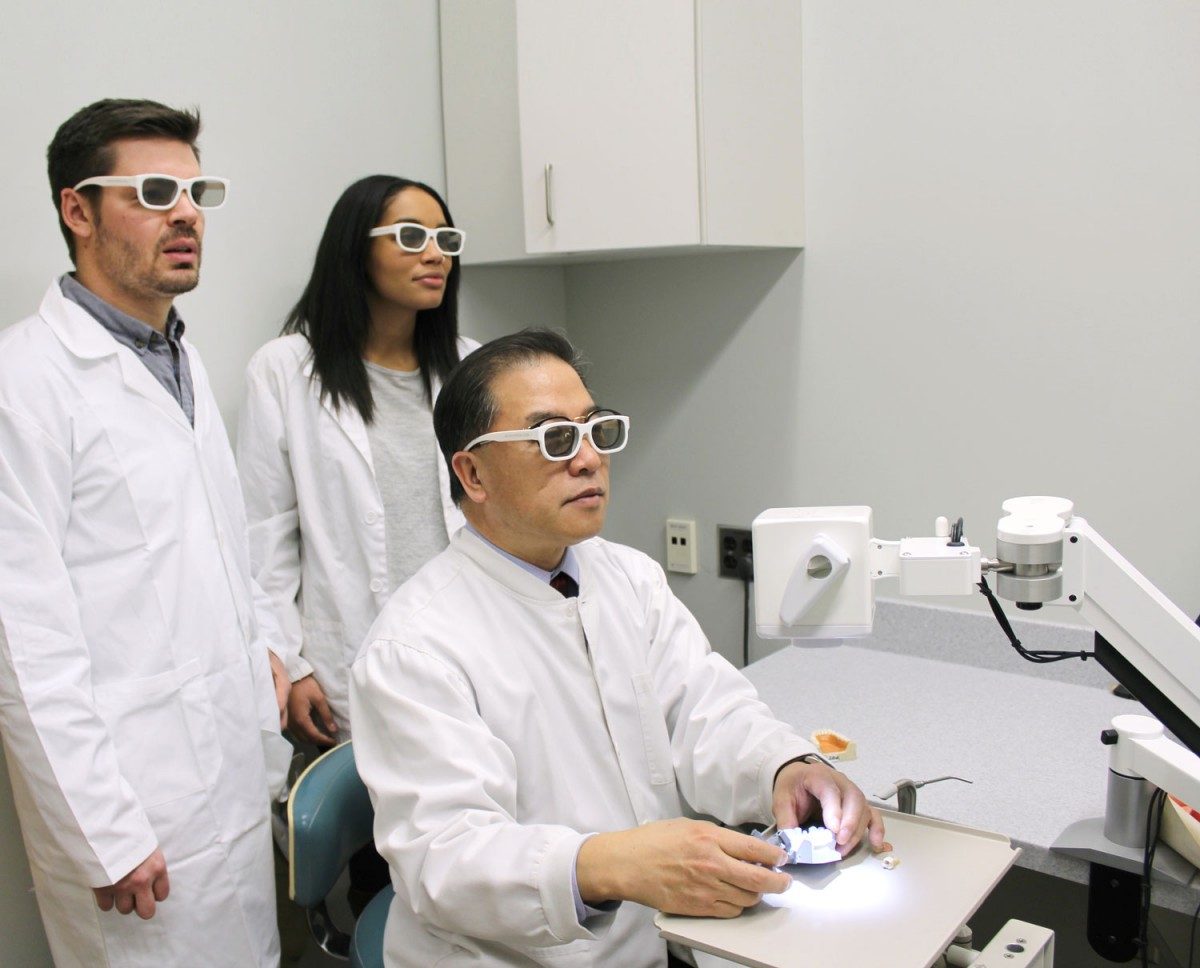
Dr. Aaron Kim (seated) demonstrates the 3D system to students Trent Lamirande (left) and Natasha Holder.
High-tech lab fosters good posture
Most dentists know only too well that constantly hunching over and twisting to see into patients’ mouths can become a pain in the neck.
It can also lead to chronic problems in practitioners’ backs, shoulders and hips. But with the advent of digital tools, pain-inducing posture is giving way to advancements in “vision ergonomics.”
“To enjoy longevity in the profession, it is critical for dentists to sit correctly, with minimal bending,” says Aaron Kim [B.Sc./82, DMD/87], associate dean of clinics at the College of Dentistry, Rady Faculty of Health Sciences. “It’s important that we educate students in using the latest tools.”
The college is ensuring that students graduate with the knowledge and skills to use leading-edge technology. That was showcased at the unveiling of the new “Dr. Sni” Lab during Homecoming Weekend in the fall of 2016.
The new, compact lab on the second floor of the Dentistry Building was outfitted largely through alumni donations to a memorial fund in honour of Taras Snihurowycz [DMD/62]. He was a respected faculty member, fondly nicknamed “Dr. Sni,” who taught at the college for decades and was known for encouraging students in their lab work. He passed away in 2011.
The $120,000 “Dr. Sni” Lab is equipped with a camera connected to a 55-inch wall-mounted monitor. The camera focuses on the oral cavity of a simulated patient, providing a real-time, stereoscopic 3D video image with up to 16x magnification. Instructors and students wear 3D glasses, much like the ones handed out at movie theatres.
The MoraVision system is the first of its kind in Canada, Kim says. It is designed for the dentist to sit behind the patient’s head – no tilting or twisting needed – and work while watching the magnified 3D image on the monitor, rather than looking directly into the patient’s mouth. A foot pedal controls the zoom and focus.
The system is an ideal teaching tool because the projected image allows a group to observe intraoral details at the same time. It can also be used in 2D format. The camera can be pointed at a tray, so a student and instructor can examine a preparation together.
“This lab is particularly designed for one-to-one feedback between instructors and students,” Kim says. “The magnified and illuminated image heightens the detailed learning experience.”
Kim notes that for the first time this academic year, dental loupes, another magnifying tool that allows for more upright posture, are being used in all pre-clinical labs and clinics. “Students are welcoming these technical advances,” he says. “It’s really nice to see the big changes.”
In their future practices, the associate dean says, students will likely choose to use loupes, microscopes or the 3D camera setup. It’s vital for them to get enough practice to become confident users of these options. “If you aren’t trained in school, it’s harder to adapt later in practice,” he says.
The “Dr. Sni” Lab includes a CAD/CAM system that scans teeth intraorally, creating a virtual model that can be used to design crowns and other restorations. A 3D milling machine in the lab can fabricate a crown in about 20 minutes.
The CAD/CAM system can be used to scan students’ preparations and digitally compare them with a sample created by an instructor. “We want to expand the use of the CAD/CAM in pre-clinical courses so students can self-scan, compare and self-evaluate,” Kim says. “That’s our goal for the next academic year.”
Patricia Kmet [B.Sc. (Maj.)/83, DMD/87], a Winnipeg dentist and alumna, spearheaded the fundraising campaign to honour Snihurowycz’s legacy. “I believe this project struck a chord with alumni,” she says. “They donated very generously, surpassing the goal of $93,000. In addition to establishing the student clinician lab in his honour, a scholarship was established that will be given annually to a deserving third-year dental student.”
The lab was officially opened during Homecoming 2016 with a reception that paid tribute to Snihurowycz’s contributions and to the generous alumni who supported the project.
Kim, a classmate of Kmet, remembers Snihurowycz’s dedication to students. “Dr. Sni would spend his evenings with us in the lab,” he says. “I’m sure he would appreciate these technological advances. He would have been thrilled to use all these new gadgets and apply them to helping students.”
This article was originally published in the Winter 2017 issue of the College of Dentistry Bulletin; click to check out the latest issue.






